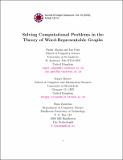Solving computational problems in the theory of word-representable graphs
Abstract
A simple graph G = (V, E) is word-representable if there exists a word w over the alphabet V such that letters x and y alternate in w iff xy ∈ E. Word-representable graphs generalize several important classes of graphs. A graph is word-representable if it admits a semi-transitive orientation. We use semi-transitive orientations to enumerate connected non-word-representable graphs up to the size of 11 vertices, which led to a correction of a published result. Obtaining the enumeration results took 3 CPU years of computation. Also, a graph is word-representable if it is k-representable for some k, that is, if it can be represented using k copies of each letter. The minimum such k for a given graph is called graph's representation number. Our computational results in this paper not only include distribution of k-representable graphs on at most 9 vertices, but also have relevance to a known conjecture on these graphs. In particular, we find a new graph on 9 vertices with high representation number. Also, we prove that a certain graph has highest representation number among all comparability graphs on odd number of vertices. Finally, we introduce the notion of a k-semi-transitive orientation refining the notion of a semi-transitive orientation, and show computationally that the refinement is not equivalent to the original definition, unlike the equivalence of k-representability and word-representability.
Citation
Akgün , Ö , Gent , I P , Kitaev , S & Zantema , H 2019 , ' Solving computational problems in the theory of word-representable graphs ' , Journal of Integer Sequences , vol. 22 , no. 2 , 19.2.5 . < https://cs.uwaterloo.ca/journals/JIS/VOL22/Kitaev/kitaev11.html >
Publication
Journal of Integer Sequences
Status
Peer reviewed
ISSN
1530-7638Type
Journal article
Collections
Items in the St Andrews Research Repository are protected by copyright, with all rights reserved, unless otherwise indicated.

